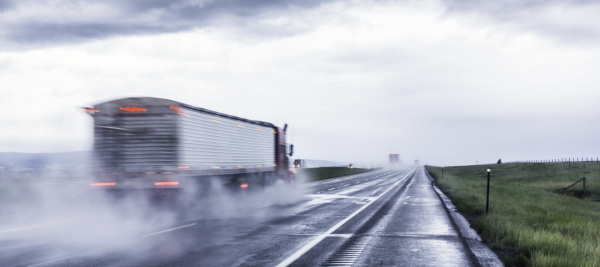Your truck driver can control many things. They can control their steering and where they stop for the night.
But, one thing that is out of their hands is the weather. Rain, sleet, hail and wind will all present themselves on different days to make their job more hazardous.
The most common bad weather condition is rain, so you need to ensure that your drivers learn how to drive safely in rain, and know how to prepare the vehicle for it.
Preventative measures before the rain
Your vehicles should be prepared for all kinds of weather, before your drivers actually encounter adverse conditions weather.
Your vehicles can be prepped for rainy conditions by:
Keeping windshield wipers in good working order. Old wipers do not provide you with a clean windshield that you can safely see through.
Properly maintaining tires. Tires that are properly filled and have deep tread will make rainy-day driving much safer.
Testing signals and lights. Before hitting the road, your drivers should test headlights, turn signals and brake lights, and make certain all are working properly. A non-functioning headlight is dangerous both at night and when it rains. The same applies to your brake lights and turn signals.
At the onset of rainy conditions, your drivers should immediately change their driving styles. They should follow these guidelines to keep themselves and others on the road safe:
- Slow down and follow the three-second rule. Wet roads can impair the speed with which your vehicle comes to a stop. Take the extra time to slow down, and don’t follow the car ahead of you too closely. To begin slowing down, your driver should try taking their foot off the gas pedal rather than braking.
- Choose the middle lane to avoid puddles in the left and right lanes.
- Your drivers should never drive through a puddle unless they can see the ground beneath it. If they have no choice but to go through a puddle without knowing how deep it is, they should do so slowly and never go through a puddle deeper than the bottom of their doors. After driving through the puddle, the driver should check their brakes before they begin travelling at faster speeds to make sure they were not adversely affected by the water.
- If the rain becomes heavy and your visibility is severely limited, they should pull over and wait until conditions are better.
- They should drive in the tracks of the vehicle in front of them.
- Your drivers should use their headlights and windshield wipers. If their visibility is restricted due to windows fogging inside the cab, they should turn up the defroster. They can also open the windows to improve the air circulation.
- Use extra caution when driving through oil patches in the road since these can be especially slick.
There are times when water on the road accumulates, and the vehicle can’t push it away from the tires. When this occurs, the vehicle can lose connection with the pavement and end up riding on top of the water.
This dangerous situation is called hydroplaning. Since the vehicle is driving on water there is no traction to be gained and it is simply gliding.
What to do if the vehicle hydroplanes:
- Slow down by taking your foot off the gas. If you are driving slowly enough, the chance of hydroplaning is reduced. If you end up hydroplaning, further speed reduction is necessary.
- Avoid using your brakes as it can force the vehicle to slide
- Avoid turning your steering wheel. This too can cause a slide.
- As you begin to slow down, your vehicle should come back into contact with the road. When this happens, you will feel more firmness in the steering wheel. At that point you can start pumping your brakes gently to slow down and you can also begin steering your vehicle to gain control.
BGES Group’s office, located in Larchmont, NY is a full service insurance agency offering, Property, Liability, Umbrella Liability, Business Auto, Bid & Performance Bonds, Inland Marine, Worker’s Compensation, New York State Disability, Group Health, Life insurance, Personal lines and Identity Theft.
Special Contractor Insurance Programs (NY, NJ, CT) – We we have 60+ insurance companies to market your general liability, umbrella liability, business auto, workers compensation, bid & performance bonds and group health coverages. We help contractors set up proper risk transfer. If you’re a contractor we offer extensive information about insurance markets, coverages, risk transfer, subcontractor screening, ways to lower your insurance costs.
BGES Group are Worker’s Compensation Specialists for the States of New York, New Jersey and Connecticut – Issues we address: 1) Lowering pricing – we have specialty programs that can save you up to 40%; 2) Finding a new company; 3) Replacing policies that are being cancelled or non renewed; 4) Audit disputes; 5) Company creating fictitious payroll at audit time; 6) Lowering high experience modifications factors; 7) Misclassification of payrolls; 8) Lowering or eliminating renewal deposits; 9) Getting coverage when you’ve been without for a few months; 10) Covering multiple states under one policy; 11) Eliminating 10% service or policy fees; 12) Timely issuance of certificates; 13) Always being able to get someone on the phone or by email when you need to.
If you would like to speak with us call Gary Wallach at 914-806-5853 or click here to email or click here to visit our website.
Company: BGES Group, 216A Larchmont Acres West, Larchmont, NY 10538
e-mail: bgesgroup@gmail.com
website: http://www.bgesgroup.com
© – Copyright – 2021 – BGES Group

